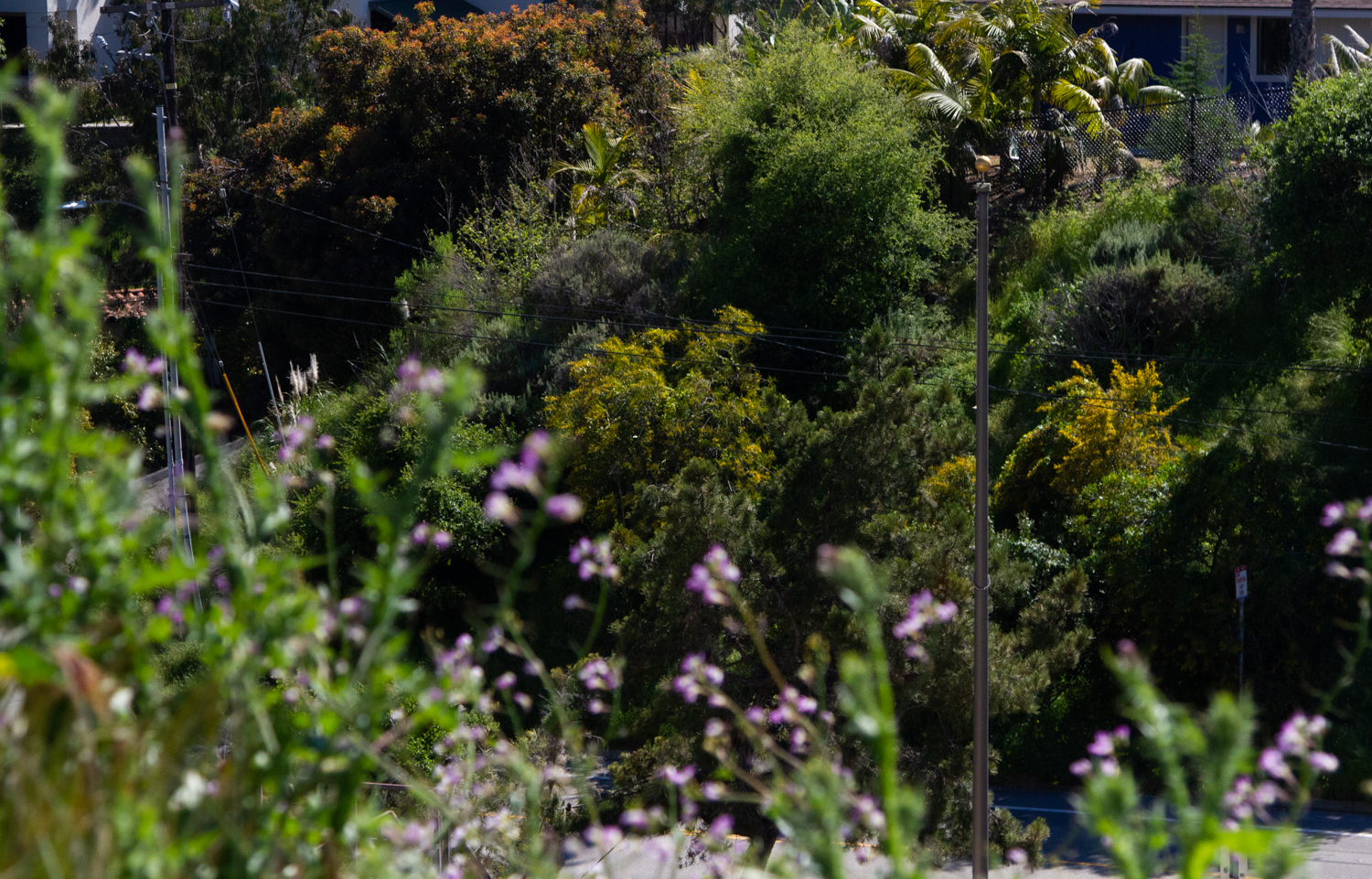Santa Barbara City College is a home for many thriving species, creating a land bursting with life
May 5, 2023
From the perspective of the treetop wildlife that looks from above, sun-rays glisten through tree branches and people passing by become rippling specks as they pass the shaded walkways with sounds of rustling leaves, birdsongs and crashing waves.
The whole campus falls quiet after hours before it comes back to life in a flurry of daily activity, but the wildlife scattered throughout City College’s acreage remain the grounds’ constant inhabitants.
The cycle of life that happens all around us is ever changing while always present. The life that exists beyond what we see and hear makes up our ecosystems and environment.
To gain an understanding of the richness of wildlife, people stepping foot onto City College’s campus have the opportunity to see varieties of birds, plants, and animals.
“The whole world unfolds if you have that prism, a mental microscope through which you see the world,” said Matt Kay, professor of botany. “If you have that perspective, you don’t need to learn every little fact, you can piece it together… That is where the fun is.”
TREES:
Located between mountains and sea, City College is constantly teeming with wildlife and creatures that are often overlooked. Lines of palm trees and blue skies are the foundations of the quintessential picturesque Santa Barbara. However, surrounding every classroom, street, and corner on campus holds a plethora of wildlife that makes up a lush environment.
“What’s interesting about wildlife is the connections,” Kay said. “I would encourage students to keep their eyes open for the birds and ask themselves how is that bird making a living? What’s it doing here? Where is their cafeteria? Where is its habitat?”
When diving deeper into the interconnectedness between species, Kay analyzed the “invisible connections” that bring the energy from the figs and benefit the Cooper’s Hawk nests above.
Lining the hillsides between campuses, there is a landscape rich in biodiversity. Littered with palms, eucalyptus, spruce, coarse live oak, Persian silk and acacia trees, the hills between campus are home to many.
Fig:
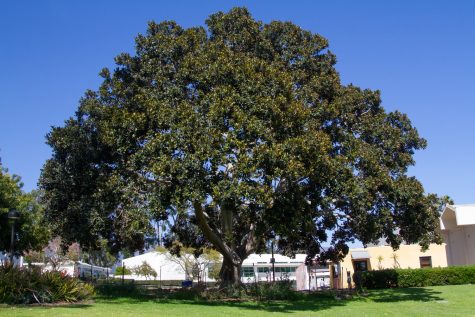
Sharing its abundance and sturdiness with every living being on campus, fig trees (Ficus microcarpa) are located all around campus. Outside the cafeteria, a fig tree beams over tables and a small grass field. Following the snaking path through East Campus, more fig trees can be spotted throughout.
Beyond the Sycamores, curving up the slope towards the Administration building, passing Canary Island pines (Pinus canariensis) and in front of the walkway canopy along the Student Services building, a grove of curtain fig trees stand together. The big towering trees produce a small brown or maroon pea sized fruit that provides sustenance for many birds that live on City College’s campus such as the Cedar Waxwing and Cooper’s Hawks.
Sycamore:
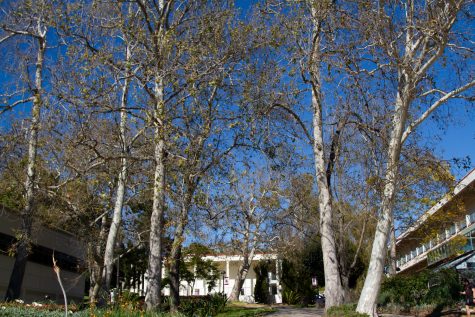
Walking from Friendship Plaza through the windy walkway towards the bridge between East and West Campus, the tall and thin trunks with bare branches during the winter are California’s native sycamore trees (Platanus racemosa) where Cooper’s Hawks nest and lots of birds visit throughout the year. Sycamores are deciduous trees with their leaves shedding in the cold months and when the warmer weather floods in, so will its leaves.
According to Nature Collective, the Chumash in the Santa Barbara region have utilized the tree bark to create wooden bowls from the gnarled branches. Nature Collective also mentions several tribes using the branches to construct homes and build wagon wheels with various resources from the sycamores which are also commonly used for medicinal purposes and coffee substitute. Among the sycamores are tropical silk floss trees (Ceiba speciosa) containing pod fruits dangling from their branches which will bloom into a magenta pink during the summer months.
Chinese elm:
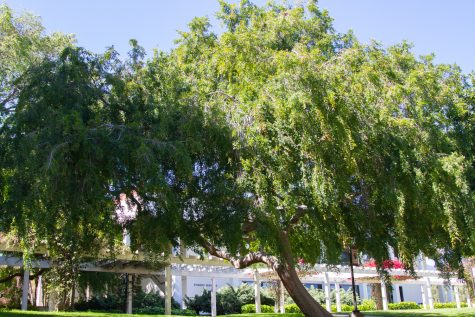
The Chinese elm (Ulmus parvifolia) is located next to the Physical Science building. With ornamental weeping branches and intricate tree bark, this tree is easily distinguishable among others.
Native to China, Korea and Japan, the Chinese elm is approximately 30-60 feet tall. Its blossoming flowers and seed spreading peaks in autumn according to a plant guide from the United States Department of Agriculture.
Jacaranda:
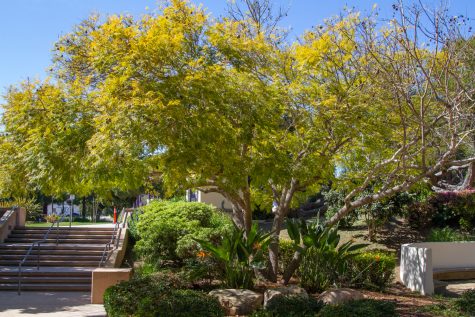
Lining streets of Santa Barbara and in the courtyard of the Administration building, a Jacaranda tree stands with light green leaves and pale brown bark during the colder months and blooms to a bright purple canopy.
With endless species and a myriad of wildlife at City College, there will always be more to see. Locust trees (Robinia pseudoacacia) bearing sweet orange fruits to feed crows, house finches and mammals and the evergreen carob trees (Ceratonia siliqua).
Native to Australia, eucalyptus trees are scattered all throughout both sides of campus. Despite their notoriety, eucalyptus trees are infamous for having negative repercussions to natural habitat by outcompeting native growing plants. A coarse live oak tree brings a flourishing habitat. With prosperous living conditions from the forest floor all the way to its canopy, the oak tree is critical for a robust habitat.
Among East Campus’s walkways, commonly seen thriving in warmer temperatures is the Canary Islands pine trees (pinus canariensis).
Typically standing 50 to 80 inches tall but reaching as high as 100 inches, these trees stand in a cone-like shape with needles and pine cones on their branches. Each pine cone takes two and a half years to fully mature and will typically be ready in autumn according to a gardening website.
BIRDS:
A campus is a “built environment” where many species, both native and opportunistic, can prosper. Those who are looking can see the extensive amount of wildlife that coexists at City College. Along with being home to raccoons, foxes, rats, squirrels and more, millions of birds share their colors and songs with passersby. Swallows, finches and juncos, monarch butterflies, and warblers fly all around campus.
“The world is an incredibly diverse and interesting place,” biology professor Jennifer Maupin said. “We have to get to know it to understand it.”
Anna’s Hummingbird:
Flying wistfully through campus, making stops at flowers and trees, Anna’s hummingbird (Calypte anna) are the most common type of hummingbird among the few found in California. The male Anna’s hummingbird has a green backside and a pink head, giving it a flashy look that allows it to stand out. Other types of hummingbirds that are often seen on campus are the Allan’s and Rufous hummingbirds, which are smaller and identifiable, according to Maupin.
Anna’s hummingbirds can be found all the way from the Alaskan coast to northern Mexico, but according to an article by American Bird Conservancy, southern California is their most common home. Additionally, instead of migrating north or south depending on the time of year, these hummingbirds will migrate to high elevation during the summer months and lower elevation in the winter.
Cooper’s Hawk:
Cooper’s Hawks (Accipiter cooperii), known to be skillful and dynamic fliers, have a horizontally streaked underside and dark feathered heads. The Cooper’s Hawk offspring feed from the fruits of the fig trees, the same source as Cedar Waxwings. They typically prey on small birds, including Cedar Waxwings.
“Cooper’s Hawk are yellow to deep red. They have good depth perception for hunting and catching prey while flying at high speeds,” reads a California nature mapping fact sheet. “The Cooper’s Hawk is from 14 to 21 inches long, with a wingspan from 27 to 36 inches. The tail is long, rounded, and barred.”
Cedar Waxwing:
Singing a high pitched song, Cedar Waxwings (Bombycilla cedrorum) fly around City College campus in groups, flying from tree to tree.
The unison workings of the ecosystem become apparent when Cedar Waxwings feed off of the small fruit produced by the fig trees, and the Waxwings are in turn eaten by Cooper’s Hawks nesting nearby. Although a Cooper’s Hawk may not land directly in the fig tree, the fig tree is linked to the survival of the Cooper’s Hawks because it provides habitat and food for their prey.

FLOWERS
Flowers serve many purposes in nature; they provide both a colorful decoration on campus as well as nutrients and pollen for many different species. Among the many native and nonnative species, there are also some that have invasive tendencies visible throughout the land.
Bird of Paradise:
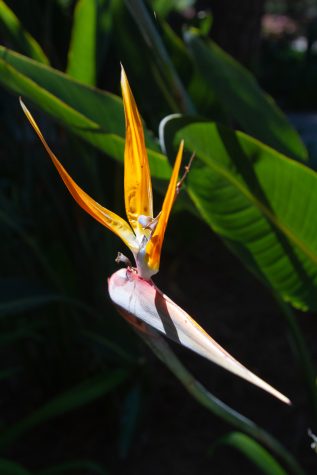
A common landscape plant native to South Africa, Bird of paradise (Strelitzia) is an eccentric plant with a very unique shape. These plants are pollinated by sunbirds. The middle portion of the flower is a purple pointy segment called the stigma where the pollinators land. Once the feet of the small songbirds land, the stigma will open to both sides, exposing its pollen allowing it to be stuck to feet and transported to other plants.
When sunbirds first land on the bird of paradise, the purple line will separate, opening a vessel where the pollen will appear and stick to the feet of the sunbirds to be transported to the next flower to land in the female anatomy of a flower. It is not efficient for the flowers to have their pollen transferred by many species. Therefore, a lot of plants have different shapes, sizes and colors to select for a narrow selection or single type of pollinator.
“By having this pollen concealed in the mechanical piece that opens up when it bears weight, now the pollen won’t be wasted on insects,” Kay said.
Hottentot-fig:
Hottentot-fig (Carpobrotus edulis), also known as ice lettuce, was introduced from South Africa to California to stabilize soils primarily around railroads and freeways and prevent soil erosion but in turn, robs the native vegetation. It flowers into small magenta blossoms that develop into a fruits that resemble a fig but are not. However, the plant is very invasive and creates a landscape of scarce biodiversity.
“In the process of excluding other large bodied plants, what the slope [of carpobrotus] doesn’t have anymore are the large woody roots from large trees that would do a better job of maintaining and stabilizing the soil,” Kay said. “It is a bit of an unintended consequence.”
Lemonade berry:
In the same family as poison oak and poison ivy, growing along the bridge is lemonade berry (Rhus integrifolia). Growing about hip or shoulder height, the green bushes contain clusters of small orange berries. These fruits contain a sour tasting center. Native to the coastal regions of southern California, lemonade berry has a place in Native American ethnobotany, as the Chumash and Cahuilla peoples use the berries to create a lemonade beverage.
Trumpet vine:
Trumpet vines grow on each side of the wooden guardrails on the campus bridge (Campsis radicans), showing off orange and pink flowers that resemble a trumpet. The flowers are pollinated by hummingbirds whose long beaks are tailored to fit perfectly inside its tubular trunks to harvest its pollen. There is a sweet nectar within the flowers center that attracts hummingbirds as well as the vibrant red color that cannot be seen by insects according to Maupin.
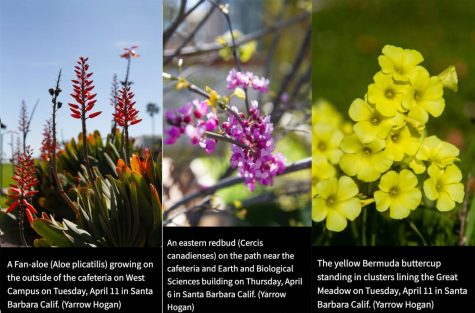
There are many trees, flowers and plants that are non-native and have been planted all around our campus for a variety of different reasons. Whether it is decorative or serving a biological purpose, implementing foreign plants comes with repercussions. Plants can become invasive or exclude native plants and directly cause negative repercussions for wildlife, ecosystems, soil stabilization and water quality.
Located on West Campus, the Great Lawn spans the majority of the acreage along the hills. The lawn is used to absorb treated wastewater and also provides a place for events to take place and students and the community to use for activities. However, this vast area of grass growth robs the landscape of plant structure for natural wildlife and habitat according to Kay. Head of Facilities Marc Broomfield explained that City College signed an agreement with the county to allow water to be recycled using the Great Meadow.
For those who watch closely, the vastness of nature and flourishing wildlife shows a unique and different perspective.
